抗性基因的宿命:土壤中有机肥源抗生素抗性基因的持久性以及生物质炭的影响规律
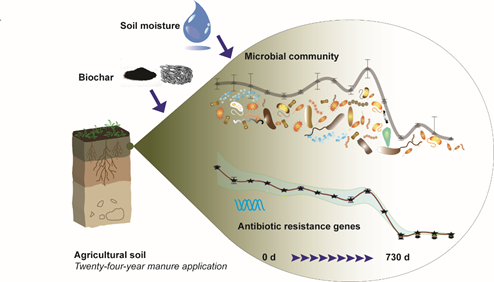

导读 | Introduction
抗生素广泛应用于人与动物感染性疾病的预防与治疗,抗生素耐药已成为全球公共健康的严重威胁。养殖动物粪肥常用于还田施肥,农田长期施用未腐熟的粪肥可在一定程度上增加土壤中耐药基因(ARGs)的丰度,土壤中ARGs的积累和持久性越来越受到关注。我们前期研究表明,在0~70 cm土壤深度中发现了79种耐药基因和各种抗生素,表明ARGs可长期累积在农田土壤中。因此,本文研究常年施用粪肥的农业土壤中抗生素耐药基因的持久性,并探讨了土壤湿度和生物质炭对ARGs消散规律的影响,为有机肥的安全农用提供依据。
Antibiotics are widely used in the prevention or treatment of human and animal diseases. Antibiotic resistance has become a serious threat to global public health. Animal manure is routinely applied to the land as fertilizer. Manure application have been documented to increase soil antibiotic resistance genes (ARGs), accumulation and persistence of ARGs in agricultural soils is a growing concern. Our previous studies demonstrated that 79 types of ARGs and various antibiotics were found at different soil depth of 0-70 cm, suggesting accumulation of ARGs in crop fields. To provide basis data for agricultural use of organic fertilizer, this study used soil microcosms to evaluate the impact of field moistures and biochar on the fate of ARGs.
一、耐药基因丰度与细菌生物量的动态变化 | Dynamic change of of ARGs and bacterial biomass
常年施肥土壤和对照土壤的16S rRNA基因丰度在8.5×10-9–1.12×10-11 copies/g之间(图1)。常年施肥的土壤细菌生物量与对照组相当,有的甚至显著低于对照组。然而,施肥处理土壤耐药基因的总丰度显著高于对照土壤。
The abundance of 16S rRNA gene in both manure-applied and control treatments ranged between 8.5×10-9–1.12×10-11 copies/g dry weight of soil (Fig.1). Manure-amended soil had as much bacterial biomass as or even significantly less than those control treatments. However, the total abundance of target ARGs in manure-soils were significantly higher than those in control treatments.
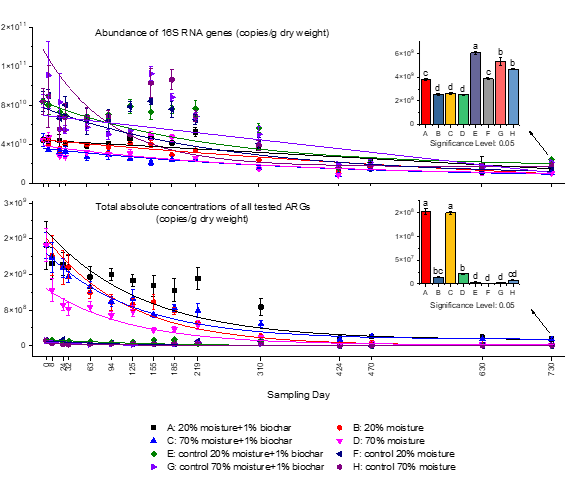
图1 耐药基因和16S rRNA基因总丰度的动态变化
Fig. 1. Dynamic change of total abundance of target ARGs and 16S rRNA gene within two years.
土壤耐药基因丰度和细菌生物量在两年内均随时间呈现出逐渐下降的趋势(图2)。其中,耐药基因总丰度从109减少至107或108copies/g。在730天时,耐药基因在添加生物质炭的土壤中的平均丰度减少至1.52 ×108±7.00 ×106copies/g,但仍然显著高于相应的对照处理组,表明生物质炭促进耐药基因在土壤中的持留。
After two years' incubation, both ARGs and bacterial biomass declined gradually with time (Fig.2). Total abundance of ARGs in these four treatments declined from 109 to 107 or 108 copies/g dw. At the end of our experiment (day 730), total concentration of ARGs in biochar-amended soils decreased to 1.52×108±7.00× 106 copies/g dw, but still higher than those in control treatments.

图2 施肥土壤(A、B、C和D处理)中耐药基因的丰度和多样性
Fig. 2. Abundance and diversity of target ARGs in manure-applied soils.
二、细菌群落结构及其多样性特征 | Structure and diversity of microbial community
放线菌门、氯仿菌门、变形菌门、厚壁菌门和酸菌门约占细菌群落的90%(图3)。放线菌门、变形菌门、厚壁菌门、酸菌门和芽孢菌门等细菌群落丰度在粪肥土壤与对照土壤中存在显著差异。 Phylum Actinobacteria, Chloroflexi, Proteobacteria, Firmicutes, and Acidobacteria accounted for about 90% of the microbial community (Fig.3). Significant differences in microbial community abundance were found among treatments, such as Actinobacteria, Proteobacteria, Firmicutes, Acidobacteria, and Gemmatimonadetes.

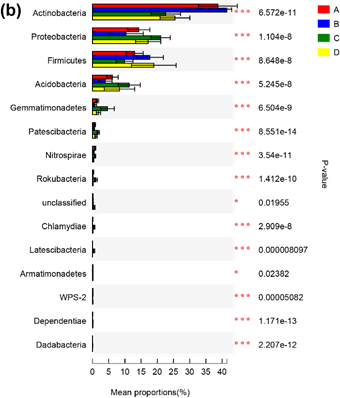
图3 土壤培养过程中微生物群落结构和多样性
Fig. 3. Structure and diversity of microbial community during soil incubation.
三、水分与生物质炭的添加对土壤耐药基因消散的影响 | Effect of moisture and biochar on the dissipation of soil ARGs
常年连续施肥土壤中耐药基因的消散规律与对照土壤呈现出不同的趋势(图4a)。水分和生物质炭对土壤ARGs和微生物群落的消散有显著影响(图4b、c)。
The fate of ARGs in soils received continuous manure application was different to that in control soils (Fig.4a). Soil moisture and biochar had significant impact on the fate of soil ARGs and microbial community. (Fig.4b and c) .
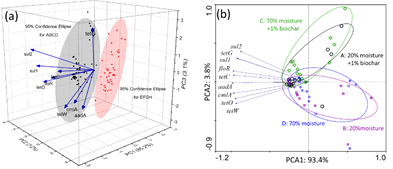
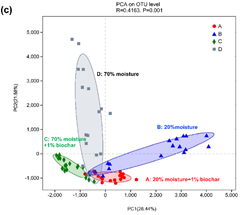
图4 土壤含水率和生物质炭对土壤耐药基因的影响
Fig. 4. Effect of moisture and biochar on the fate of target ARGs in soil treatments within two years.
总结 | Conclusions
连续施用未腐熟猪粪导致ARGs在农田土壤中积累,在两年内ARGs的丰度下降了一个或两个数量级。ARGs在20%水分土壤或生物质炭添加的土壤中消散较慢,生物质炭的添加有助于维持细菌菌群多样性,却导致耐药基因的蓄积,减缓ARGs在土壤中的消散,研究结果为农田土壤粪肥施用和ARGs的风险评估提供数据支撑。
Continuous manure application induced an accumulation of ARGs into soil, wherein abundance of ARGs declined by one or two order of magnitude within two years. ARGs dissipated more slowly in 20% moisture soil or biochar-amended soil. Overall, biochar amendment contributed to maintain bacterial diversity, sustain ARGs and delay their dissipation in soil. The results provide important data for the risk assessment of manure application and soil ARGs.
本文内容来自ELSEVIER旗舰期刊Sci Total Environ第787卷发表的论文:
He, L. Y., et al., Dissipation of antibiotic resistance genes in manure-amended agricultural soil. Science of The Total Environment 2021, 787: 147582.
https://doi.org/10.1016/j.scitotenv.2021.147582